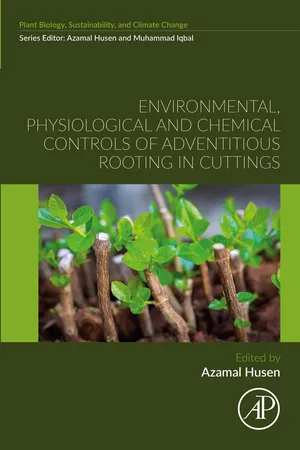
Environmental, Physiological and Chemical Controls of Adventitious Rooting in Cuttings
- 520 pages
- English
- ePUB (mobile friendly)
- Only available on web
Environmental, Physiological and Chemical Controls of Adventitious Rooting in Cuttings
About This Book
Environmental, Physiological and Chemical Controls of Adventitious Rooting in Cuttings provides a review of the environmental, physiological and chemical controls of adventitious rooting in cuttings obtained from plants. In plants, adventitious roots, which are highly useful for vegetative propagation (or clonal propagation) are produced mainly from leaves, hypocotyls, stems or shoots. Vegetative propagation may occur naturally by using propagules such as roots, underground and aerial stems, leaves, buds and bulbils. It may also be done artificially through regenerative organs (rhizomes, bulbs, and corms) and by utilizing specialized methods, like cutting, grafting and layering. This book covers the latest tactics surrounding these processes.
As a plethora of factors affect the adventitious rooting of cuttings, adding to the complexity of the phenomenon. The main factors which control adventitious root formation are types of cuttings, presence of leaf area on cuttings, types of hormones and their concentration, duration of hormonal treatment (quick dip, long soak, dry dip, spray dip, or total immerse method), maturation (juvenile or mature), genotype, explant position, and more, all of which are discussed here.
- Provides a comprehensive and exclusive book on the environmental, physiological and chemical factors associated with adventitious root formation in cutting, with up-to-date literature and lucid illustrations
- Presents a multidimensional approach and a broad range of explanation on adventitious root formation associated with mature and juvenile cutting
- Discusses a number of molecular, histological and physiological markers associated with adventitious root formation in numerous plant species
- Elaborates on how external and internal factors control the cell/tissue initiation, differentiation and overall adventitious root formation in cutting
Frequently asked questions
Information
Table of contents
- Cover image
- Title page
- Table of Contents
- Copyright
- Dedication
- Contributors
- About the editor
- Preface
- Chapter 1: Physiological and environmental control of adventitious root formation in cuttings: An overview
- Chapter 2: Molecular control of adventitious root formation
- Chapter 3: Natural variation in adventitious root formation
- Chapter 4: Wound response and primary metabolism during adventitious root formation in cuttings
- Chapter 5: Revisiting the anatomical changes during adventitious root formation in cuttings
- Chapter 6: Metabolism during adventitious root primordia initiation and development
- Chapter 7: Role of plant growth-promoting Rhizobacterium in adventitious root formation
- Chapter 8: Adventitious root formation after cuttings and its regulation by transcriptome analysis
- Chapter 9: Role of various auxins in adventitious root formation
- Chapter 10: Role of cytokinins in adventitious root formation
- Chapter 11: Role of phenolic compounds in adventitious root formation
- Chapter 12: Role of polyamines in adventitious root formation
- Chapter 13: Role of hydrogen peroxide in adventitious root formation
- Chapter 14: Role of nitric oxide in adventitious root formation
- Chapter 15: Strigolactones: A new player in regulating adventitious root formation
- Chapter 16: Role of plant stem or shoot cutting positions and hormone treatments in adventitious root formation
- Chapter 17: Adventitious root formation in cuttings as influenced by genotypes, leaf area, and types of cuttings
- Chapter 18: Adventitious root formation in cuttings and effects of maturation
- Chapter 19: Micropropagation in mature trees by manipulation of phase change, stress, and culture environment
- Chapter 20: In vitro micrografting to induce juvenility and improvement of rooting
- Chapter 21: Adventitious root formation in ornamental and horticulture plants
- Chapter 22: Adventitious root formation and clonal propagation of forest-based tree species
- Index